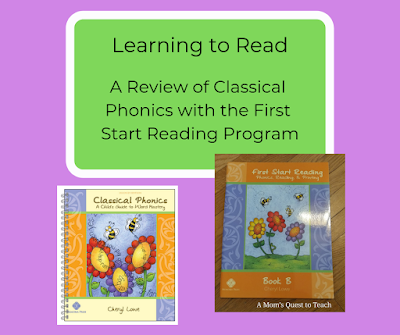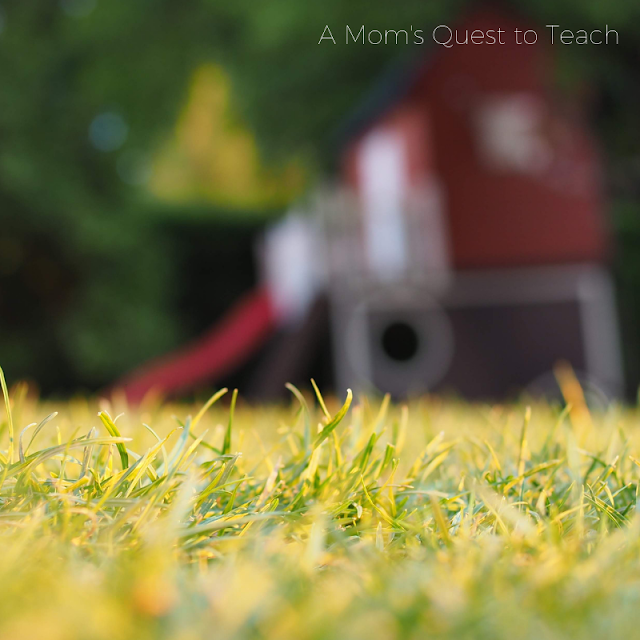Each day our five-year-old son brings me the Teacher Guide of the
First Start Reading Program and First Start Reading Book A published by
Memoria Press and asks to work on his homeschool lessons. I would say this deserves a resounding recommendation from him as he has enthusiastically worked on these lessons and reads through
Classical Phonics which is geared towards kindergarten and first grade students.
What Am I Reviewing?
- Classical Phonics, Second Edition
- Teacher Guide for First Start Reading Program
- Books A-E for First Start Reading Program
- First Start Reading Book E Teacher Guide
Classical Phonics: A Child's Guide to Word Mastery
Cheryl Lowe writes in the preface to the 2010 edition: "
Word Mastery is in fact a little gem, a well-organized and methodical presentation of phonics." There are changes from the original publication (1913) which include graphic and illustration changes, reduction of the number of words per page, and reorganization of words to make it easier for kids. Classical Phonics can be used to supplement any phonics programs and is a good fit for the First Start Reading Program from
Memoria Press.
There are four parts to the spiral-bound book (the fact that it is spiral-bound helps it to lie flat on a table or desk). The introductions to the units for the teacher or parent provide the goal of the unit and an explanation of what will be taught in that unit. For example, the Introduction to Unit 3 states that consonant blends will continue to be taught, final blends in short-vowel words will be covered first, initial blends are organized into three categories (s, l, and r blends), and examples of what the book is addressing are provided.
At the end of the 139-page book Classical Phonics, there are suggestions for the teacher which should be read prior to giving the book to children per the 1913 publication recommendations. There are also phonics and spelling rules and lists of common words provided on the final pages.
 |
| Our daughter looking through Classical Phonics while her brother works on writing the letter H. |
Part One introduces the letters in a similar format to the First Start Reading Book A which is helpful for our son to review what he has learned. There are also additional words listed that demonstrate different uses of the vowel or consonant. For the letter T, the images are the same as Book A but include the words with T as the terminal (letter at the end of the world like mat and sat) as well as the initial sound (like tan and ten).
I do wish that the Teacher Guide for Books A-D would be more specific as to when to use Classical Phonics. For example, during lesson 14, when reviewing the sound 'ft' students are referred to page 57 of Classical Phonics where there is a list of 6 other 'ft' words (in addition to six other final consonant blends). One way I intend to use Classical Phonics in addition to the ways suggested, is to use the lists for spelling words for our son.
Each book lists the table of contents of the particular book at the front of the book. Here is a brief overview of what each book teaches.
First Start Reading Book A covers ten letters/sounds, thirty-six common words, as well as punctuation, articles, capitalizing at the beginning of sentences, plural nouns, and more. The 68 pages include a word mastery review with the word families of am, an, at, and ap, pages for students to read words and then write down the words as you dictate them.
First Start Reading Book B is a little over 70 pages long with 26 lessons, a review, and an assessment. There is more of an emphasis on stories to read using the words introduced than just sentences and the question mark is introduced in Lesson 17. The letters and sounds that are addressed in Book B include short I, G, L, O, B, and D.
First Start Reading Book C is the longest with over 100 pages, ten letters and sounds, a variety of common words, and the introduction of quotation marks and paragraphs. The lessons on individual letters still follow the same format of an image to color in, a box for the student to draw something that starts with or has the sound of the letter (as in the case of the letter X), and space to practice writing the lowercase and uppercase letters. The stories are longer and some of the sentences continue onto the next line.
First Start Reading Book D examines the long vowel sounds, digraphs of sh, th, ch, and wh, final consonant blends, and s-, r-, and l-blends. The lessons in Book D cover more pages than the previous books. For example, Lesson 4 (the silent e) has the introductory coloring page, tracing and writing page, additional writing, illustrating page, and assessment pages.
First Start Reading Book E completes the series by discussing long vowels, soft c and g, and the three sounds of y. There is an introduction to each sound, the writing of words and sentences to read. There is also a short story to read as well as questions in the Teacher Guide. Included in Book E (similar to the other books) is a spot for dictation words and an assessment page for children. This is a perfect book to build up to with your children.
How We Are Using the First Start Reading Program

Our five-year-old son is working through Book A as part of his regular language arts instruction in our homeschool. We plan on continuing to work through Books B-E and anticipate completing them by December 2019. As we operate on a more relaxed schedule with our two younger children, there are some days where we complete two lessons and others where we skip doing a lesson that day. Taking into consideration our homeschooling style, the First Start Reading program may take us about a year or more to complete.
Prior to teaching each lesson, I review the information in the Teacher Guide. Then we work through the lesson as presented using our small white board, Book A, and the Teacher Guide. The lessons are progressive in that they build upon previous letters and words learned.
Having learned the letters A, T, M, S, F, and R in previous lessons, Lesson 14 asks students to blend together A and T to form AT. They then blend together M and AT, S and AT, R, and AT, F, and AT to make mat, sat, rat, and fat. Our son then traced the sentence "I am tan" and a few other sentences. After the lesson, our son practiced the letter H and then for Lesson 16 learned about apostrophes and formed two new words using the letter H (hat and ham).
 |
| We use our small whiteboard on a regular basis with the lessons. |
Students are not just working with one letter after another. As they progress through the lessons, they learn letters and sounds and then create words and sentences.
Our five-year-old son really enjoys drawing and coloring the pictures that accompany each lesson. He has been consistently working on proper writing along with pronouncing the vowels and consonants. And even though our three-year-old is not using the workbook, she is joining in on the lessons to recognize letters and listen to the pronunciations.
What We Like
I really liked the phonics overview in the 330-page Teacher Guide. Teaching phonics and the early skills required in language arts has always been one of my fears in homeschooling our younger children. I read through the first several pages of the Teacher Guide multiple times to help me get a hold of the philosophy and teaching methods of First Start Reading.
The Teacher Guide is written for both teachers and homeschooling families. Most of the information presented is geared towards a classroom setting. For example, the guide tells you to "walk around the room and put a star on each student's best letter."
 |
| Optional lessons that reference Classical Phonics. |
There are optional lessons which cover consonant blends and the four h-consonant teams. These lessons will be covered in Book D but are included early to help too much information from being presented at the end of Kindergarten. These optional lessons reference Classical Phonics on a number of occasions.
There is also a page addressing the proper pencil grip as well as three pages at the end of the Teacher Guide to display to help children hold their pencils correctly.
In general, each lesson is covered on two pages in the Teacher Guide while some of the reviews and assessments are on more than two pages. There is also room on the pages to make notes before, while, or after teaching the lesson.
One fault: the Appendix of the Teacher Guide for Books A-D is printed double-sided which means I can't just pull out the pages to hang up as recommended. These pages consist of early lessons that teach proper pencil holding and reviewing left from right, discuss hanging the mitten, writing poster, and other pages up in your classroom. If they were printed single-sided, I could easily remove them from the book and hang them up for our son. Without easy access to a photocopier or scanner, I can't hang up all the vowel posters, writing posters, etc.
Do you wish to learn more about Memoria Press and their products?
If you wish to learn about other products from Memoria Press, be sure to check out the other
reviews. Members of the The Old Schoolhouse Magazine Homeschool Review Crew also reviewed poetry curriculum and Latin curriculum.
 Finding Success
Finding Success






















































